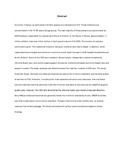| dc.description.abstract | Currently in Kenya, an estimated 2.2million people are infected with HIV. These infections are concentrated in the 15-49 years old age group. The vast majority of these persons are parents and so, AIDS has been responsible for orphaning millions of children in the Kenya. In Kenya, approximately 1.1 million children have lost either mother or both parents due to HIV/AIDS. The number of orphans continues to grow.
The traditional means of caring for orphans have had to adapt, in addition, other responses have emerged and continue to evolve to avoid rapid increase in child headed households and street children. Some of the OVC care models in Kenya include: independent orphan households, informal foster care, community based support structures, institutional based and home-based care and support models. This study analyzes cost effectiveness of the last four models ofOVC care.
The study finds that Grace- Outreach provides services that are above the rmrumum standard, and the best quality of services to OVC. However, it employs the most expensive structure and resources. Informal foster care provides services that generally meet the minimum standard of care and can be classified as good quality care. However, the CEA ratio shows that the informal foster care model is less cost effective. Sony HBC provides services that are generally below the minimum standards of care. LRCDP provides care that is also below the minimum standard. Though it claims to provide holistic care, no orphan receives that holistic package. The study concludes with policy recommendations based on these findings . | en |

